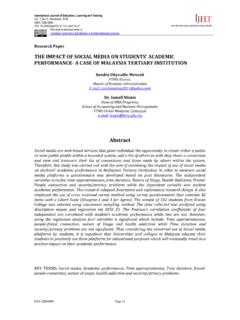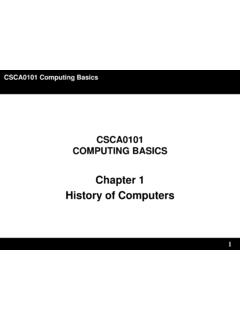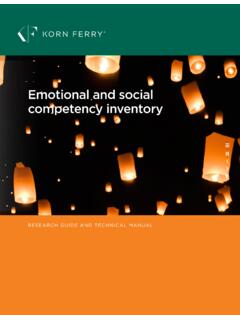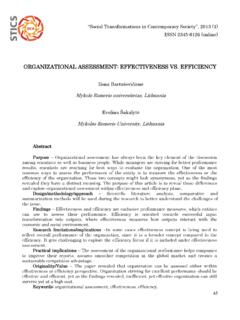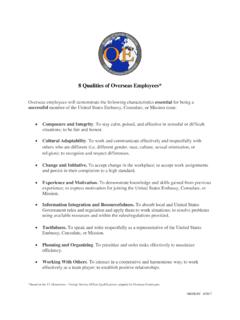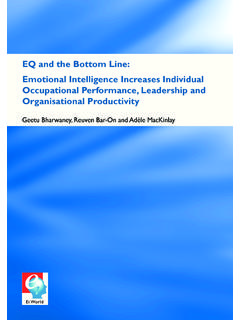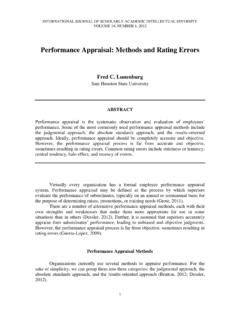Transcription of LEADERSHIP STYLE AND ITS IMPACT ON EMPLOYEE …
1 ISSN: 2289-4519 Page 80 International Journal of Accounting & Business Management Vol. 6 ( ), April, 2018 ISSN: 2289-4519 This work is licensed under a Creative Commons Attribution International License. Research Paper LEADERSHIP STYLE AND ITS IMPACT ON EMPLOYEE PERFORMANCE Joyce Chua MBA Graduate Lord Ashcroft International Business School Anglia Ruskin University, UK Abdul Basit Lecturer School of Accounting & Business Management FTMS College, Malaysia Zubair Hassan Senior Lecturer School of Accounting & Business Management FTMS College, Malaysia ABSTRACT The aim of this study was to determine the IMPACT of LEADERSHIP STYLE on EMPLOYEE s performance. A causal research design was used to carry out this research. Middle management employees from services sector at different of location in Klang Valley was used.
2 To do this, respondents from a hearing aid company was chosen. Each respondent should have worked more than 5 years in the field. A Likert scale from 1-5 was used to collect data, where the questionnaire was tested for its face, content and construct validity along with reliability of the construct. A sample size of two hundred and fifty (250) respondents was used using non-probability convenient sampling method. Regression analysis was conducted to analyses the data using SPSS 21. The result shows that autocratic and democratic LEADERSHIP STYLE has positive and significant IMPACT on EMPLOYEE performance. However we found that laissez-fair LEADERSHIP STYLE have no significant influence on EMPLOYEE performance.
3 This suggests that leaders with extremely distinguished styles have more influences on EMPLOYEE performance as it is more evident throughout their interaction with the immediate supervisor. Therefore, leaders could adopt innovative strategies using suitable LEADERSHIP STYLE in order to achieve work performance at the very best level as well as to gain the long-term success. Therefore we concluded that the autocratic LEADERSHIP is useful in the short term and democratic LEADERSHIP STYLE is useful in all time horizons to improve EMPLOYEE performance. Future research could consider employees reporting immediate supervisors for last five years to ensure more constructive feedback about the LEADERSHIP STYLE practices by the managers.
4 Also the study should cover a larger sample using more systematic sampling technique to generalize the result. Key Terms: LEADERSHIP STYLE , autocratic, democratic and laissez-fair LEADERSHIP STYLE , EMPLOYEE performance ISSN: 2289-4519 Page 81 1. INTRODUCTION This study focus on examining the IMPACT of LEADERSHIP styles on EMPLOYEE performance. The historical perspective of LEADERSHIP indicated that recently LEADERSHIP is used as an effective management approach to manage large size organizations (Iqbal, Anwar & Haidar , 2015). The gradual replacement of personnel administration with human resource management results integration of LEADERSHIP styles into effective EMPLOYEE management or performance (Iqbal et al, 2015). This demands leaders to adapt themselves to various situation when demand arise to ensure there is effective LEADERSHIP (Heresy & Blanchard, 1988).
5 Different LEADERSHIP styles were used based on the amount of direction, decision making power and empowerment (Iqbal et al, 2015). When it comes to administration the LEADERSHIP , situation and performance of employees are loosely connected and let to hang on their own (Iqbal et al, 2015). This has caused poor EMPLOYEE performance due to the lack of direction and strategic LEADERSHIP in managing routine work. Many researches, in the past examined the performance and factors affecting EMPLOYEE performance. One of the dominant key factor that have been discussed in the past researches were LEADERSHIP such as participative, autocratic, and democratic (Iqbal et al, 2015). Similarly many researches were done to examine the performance and how it was affected by various LEADERSHIP styles.
6 Most of the studies were highly lacking the data collected on Malaysian context, especially on employees performance and LEADERSHIP STYLE in commercial service such as ear hearing service providers. The three LEADERSHIP STYLE was considered as dominant in the past literature, although no research was conducted to examine these styles in the hearing aid sector s working managers to examine at what extent the STYLE of LEADERSHIP affected its employees. (Iqbal et al , 2015).) To achieve the aim of this study, the following objectives are formulated To examine the IMPACT of autocratic LEADERSHIP STYLE on EMPLOYEE Performances To examine the IMPACT of democratic LEADERSHIP STYLE on EMPLOYEE Performances To examine the IMPACT of laisses-fair LEADERSHIP STYLE on EMPLOYEE Performances The rest of the paper is organised with four section.
7 The next section will focus on literature review, followed by research methods and data collection procedures, data analysis and discussions and conclusion & recommendations. 2. LITERATURE REVIEW LEADERSHIP is the most cogitating and investigate at organizational variable, the leader has a potential IMPACT on EMPLOYEE performance (Cummings & Schwab, 1973). The concept of LEADERSHIP is originally developed in folk psychology to explain the factor of LEADERSHIP STYLE IMPACT on EMPLOYEE (Jaskaran & Sri-Guru, 2014). LEADERSHIP is the process by which a person exerts influence over people and inspires, motivates, and directs their activities to help achieve group or organizational goals (Jones & George, 2004). LEADERSHIP is essentially a process in which one individual or sometimes a small group of individuals influences the efforts of others towards the achievement of goals in a given set of circumstances (Cole, 2005).
8 LEADERSHIP STYLE is a pattern of behaviours which engaged in by leader when dealing with EMPLOYEE . Lewin, Leppit, and White (1939) acknowledged three LEADERSHIP styles such as autocratic, democratic and Laissez-Faire. Vigoda-Gadot (2007) argued that , every leader in their organization and operations practices particular LEADERSHIP STYLE where such styles is referred as a set of the behaviour patterns, LEADERSHIP frequently occurs during the constant organizational work and others knows leaders by LEADERSHIP . The manager of the organization is in very cooperation with the EMPLOYEE , the LEADERSHIP STYLE of these managers ISSN: 2289-4519 Page 82 has a significant IMPACT on EMPLOYEE self-confidence. Consequently it was found that the EMPLOYEE self-confidence has a positive IMPACT on performance (Shirzad & Zanganeh, 2011).
9 Jago (1982) argued that the good leaders are made, but not born. If the person has the desire and determination, he/she can become an effective leader (Jago, 1982). Good leaders develop through a never-ending process of self-study, education, training, and experience (Jago, 1982). The other popular definitions of LEADERSHIP stated that it is more about an individual who influences a group of people to achieve a common goal (Northouse, 2017). According to Zeitchik (2012), LEADERSHIP about inspiring others to trail the vision until it becomes a shared effort to achieve the vision. Cole (2005) defined LEADERSHIP as a dynamic process whereby one man influences others to contribute voluntarily to the realization and achievement of the goals and objectives.
10 LEADERSHIP STYLE is the most dominant factors that IMPACT employees attitudes and behaviours including organizational commitment. LEADERSHIP can be defined as the capacity to IMPACT a group of employees decision, behaviour, recognition of the goal, and work with confidence and zeal (Adair, 2002). Leader is required to develop the future vision, to motivate the organizational members, and to achieve the visions and to improve the performance (Adair, 2002). According to Adair (2002) LEADERSHIP is the ability to encourage others to seek out and defined objectives enthusiastically. It is the human factor which binds a group together and to improve their performance and to direct them towards goals (Koudri,1999). Also it was suggested that LEADERSHIP is to deal and cope with change, focus on the long-term and the big picture, not always keep to save him/herself to take risks, and concentrating on people and their values, not just only the bottom-line (Koudri, 1999).
